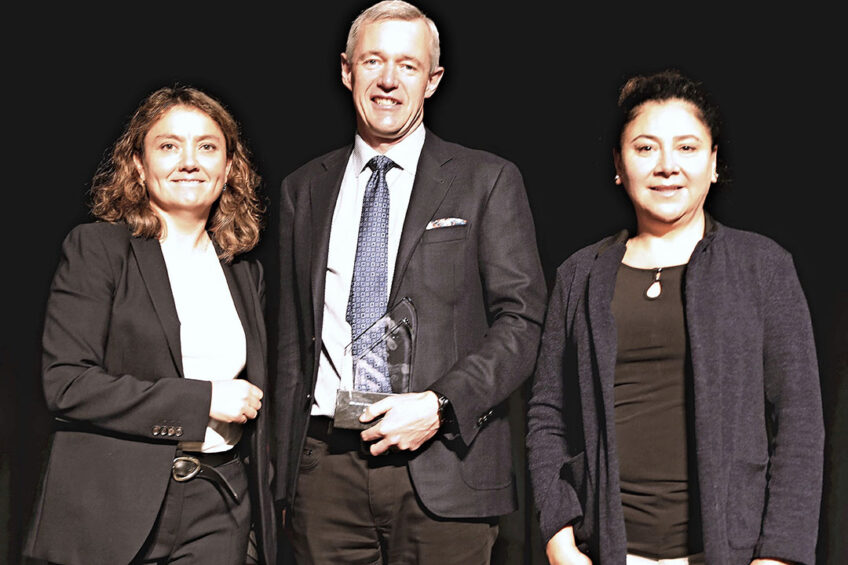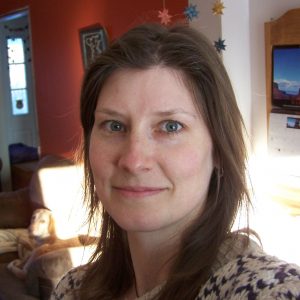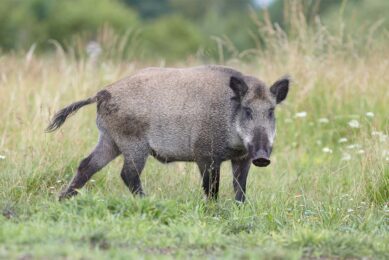Interview Dr Egan Brockhoff: A love of epidemiology and mentoring

As the investigation into African Swine Fever (ASF) in the Dominican Republic and Haiti continues, Canadian swine veterinarian Dr Egan Brockhoff will play a pivotal role in preventing entry of foreign swine diseases into North America. For that, and his many other roles, he has won the 2021 Allen D. Leman Science in Practice Award.
Dr Egan Brockhoff is foremost among those in Canada who have done an astonishing amount of work to improve the Canadian pork sector and contribute to its global success. Over his career, he has fostered a closer working relationship between the Canadian Pork Council (CPC) and the swine veterinary community and has served as the CPC veterinary counselor since 2014. He has also done much to increase interest in swine veterinary medicine through his mentoring and teaching activities.
Now, with Porcine Epidemic Diarrhoea (PED) very much contained in Canada but the threat of ASF entry as high as ever, Dr Brockhoff reflects on the latest biosecurity activities in North America and beyond, his past achievements and what’s ahead.
PROFILE
Dr Egan Brockhoff is a graduate of the Western College of Veterinary Medicine at the University of Saskatchewan. He is the past president and a practising veterinarian with Prairie Swine Health Services in Red Deer Alberta. He has served in numerous professional and industry leadership roles including president of the Alberta Veterinary Medical Association. In 2020, Dr Brockhoff received the ‘Merck Veterinary Award for Food Animal Veterinarian of the Year’ from the Canadian Veterinary Medical Association and in 2021 the Allen D. Leman Science in Practice Award Winner.
How did you come to be a swine veterinarian?
“When I graduated from high school, I took a livestock production and management course at Olds College here in Alberta. Then I went back to our family farm, which is a large grain, beef feedlot and cow-calf operation. By my late twenties, I had also grown my own purebred Simmental beef cattle herd to 120, and then we had a disease outbreak. It was Salmonella, and it was devastating for my purebred herd and the rest of our cows. We didn’t know it at first, but we had brought it back to the farm after taking one of our cows to a veterinary clinic. The two months we spent trying to understand what was happening and getting the situation under control were two of the worst of my life.
“But it also really got my mind working about what needed to be done on a population and biosecurity level to prevent spread of disease. It was a terrible event on our farm, but with that, I fell in love with veterinary medicine. The year after, I started pre-vet courses. My family was very supportive.
“During my veterinary degree, I did some population medicine courses in the US during the summers, and one of them was a pig course and I really got interested. My first job as a vet was at a large practice that focused on beef cattle feedlots but also had some swine clients, which I serviced. I had also started to do some swine population medicine projects and policy work for different organisations and I really liked it. By the end of that year, I had moved to Prairie Swine Health Services and the year after, I bought into the practice.”
What was it about population medicine that caught your interest?
“It is the complexity of it, looking at all the intricate moving parts and how they work together. I couldn’t not fall in love with the complexity. Population medicine forces you to think in a different way; you just stare mentally at how different diseases move and different strains of the same disease move and how movement is different if a few variables are changed.
“I also love the diagnostics. There are a lot of analysis and post-mortems with pigs and we are not just identifying pathogens, we are doing genetic sequencing and building our own vaccines and developing response plans.
“I was also really fortunate that I entered the industry at a time when there was a lot of support for population medicine, an interest in benchmarking and a new constant desire for improvement. With colleagues, we built the Canadian Swine Health Intelligence Network, a partnership between the CPC and the Canadian Association of Swine Veterinarians. Farmers wanted more than just veterinary services and herd health programmes; they wanted to have bigger discussions about health. I had helped the CPC launch its animal care assessment but a lot of companies wanted to go beyond that, so we at Prairie Swine Health Services introduced an animal welfare audit system around 2010. A lot of farmers also wanted ways to measure how their teams were doing and how their processes were going. So we introduced things like piglet processing audits, and evaluations of whether barns were suitable for raised-without-antibiotic production. It grew month by month and the more we did to create these spaces for discussion and change, the bigger it got.”
Being a good mentor to my team has always been front and centre, and I get as much reward from that as from anything else
You have also, since 2008, taught Swine Medicine at the University of Calgary’s Faculty of Veterinary Medicine. What do you get from it?
“Practically, it allowed me to meet and recruit young vets who were interested in population medicine. Dr Chris Misutka, the founder of our practice, had the confidence in me to let me run with it and grow it. So we moved to a six-person practice in short order.
“But being a mentor has been a very exciting thing for me. Being a good mentor to my team has always been front and centre, and I get as much reward from that as from anything else. I had my first new young vet hire, Dr Jessica Law, do a research project and every one of our new vets after that has done the same. It’s a great way to get them to know the farms and the people and how the industry works. When Jessica presented on her project, which was about pain management, at a meeting, a new young vet called Dr Kelsey Gray saw it and was blown away that there was a practice that provided such opportunities. So she approached me about being hired and I hired her. I think that when young people are given opportunities, it is very exciting for them and it creates a lot of positive energy. I have an amazing team.”
What did your work entail during Canada’s PED outbreak?
“When PED arrived in the US in 2013, I called up CPC and Alberta Pork and other organisations and I told them this was going to be a game-changer. It arrived in Canada by January 2014. We figured out quite quickly at that point that the outbreak here was linked to a certain feed ingredient, and it was not known at that point that the virus could be transmitted in feed. I went with my CPC colleagues in 2018 to the Canadian Food Inspection Agency (CFIA) with all the research and we worked together to come up with changes to how high-risk feed ingredients were imported into Canada. Since March 2019, Canada has had control zones and permits for import of feed ingredients from countries with ASF, and the CPC has provided time and temperature recommendations for processing feed.
“The biggest challenge with PED was that there was a steep learning curve. A lot of people thought it was going to be like transmissible gastroenteritis (TGE), which has nearly-identical lesions and identical clinical signs, and we had had TGE in North America. Also, the industry here didn’t think PED was too serious because in Europe it wasn’t a huge issue. But it was a less infectious strain of PED in Europe. We had a very infectious strain here, with huge amounts of virus being produced. So we had to realise we had a lot to learn about how to eradicate it. I had worked in South-East Asia in 2008 to help them deal with PED and so I used that knowledge.
“Also, by 2010, we had developed as an industry in Canada national biosecurity standards addressing Porcine Reproductive and Respiratory Syndrome and a lot of other diseases, including training and benchmarking and following up for every farm in Canada, so we had that and it really helped with our PED response. All this meant that we never had the PED struggles that other countries had. But we did a lot of work, particularly on transportation and truck cleaning.”
It was and is a pleasure to spread knowledge about best practices and apply the concepts of population medicine
In 2010, you started travelling to Asia to teach about pig disease control. How did that begin?
“I met a vet from the Philippines during a course at Iowa State University, and he said ‘You have to come to my country and speak’. So, in 2010, I spoke at a bunch of events and then I went back every year to teach and present at events. A lot of the swine vets in attendance were from different countries in South-East Asia, and so I got invitations to come to China, Taiwan, Vietnam and so on. It was and is a pleasure to spread knowledge about best practices and apply the concepts of population medicine.”
You have provided critical input to developing measures designed to prevent entry and, if necessary, response to an outbreak of ASF in Canada and North America, including the creation of an industry–government pan-Canadian ASF strategy. With the detection of ASF in the Dominican Republic and Haiti, what are your biggest concerns?
“This outbreak reminds us that this virus is still moving around the world and can show up such a distance from infected countries. We still don’t know how it came there, if it was kitchen garbage from a ship getting fed to pigs, or some other way.
“Right now, I meet on the phone or online at least twice a week with CFIA and at least weekly with US colleagues. And a large part of the current discussion is about how we can help with our Central and South American colleagues. For example, in 2020 and 2021, some colleagues and I created biosecurity resources for Canadian backyard pig producers and gave them to CFIA, and they have introduced them in their OIE discussions. We also discuss how we can help with diagnostics and containment. The whole Caribbean region is now at very high risk. There is so much we don’t know. Did it start in Haiti? Can it be contained?
“The virus has already had time to move. If ASF becomes established in the Caribbean region, it is very scary because North and South America are very close.”
 Beheer
Beheer








 WP Admin
WP Admin  Bewerk bericht
Bewerk bericht